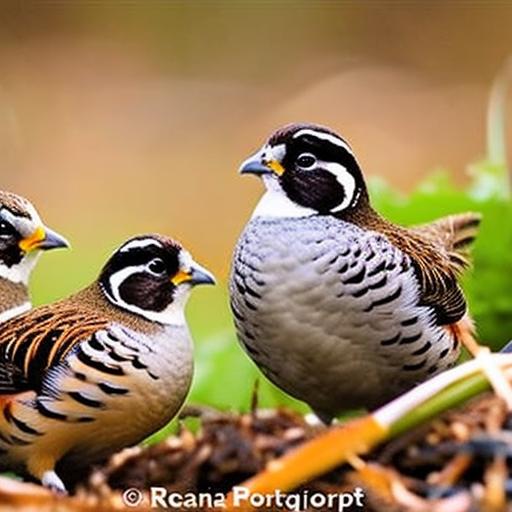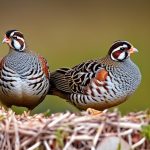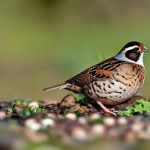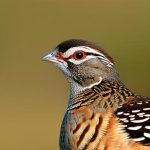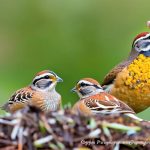When it comes to choosing the right housing for indoor quail, there are a few key factors to consider. Firstly, the size of the enclosure is crucial. Quail are active birds and need plenty of space to move around. A general rule of thumb is to provide at least 1 square foot of space per quail. This means that if you have a small flock of 6 quail, you will need a minimum of 6 square feet of space for them to live comfortably. Additionally, the height of the enclosure is important as quail are known to be good flyers. A minimum height of 12 inches is recommended to prevent any potential injuries from flying into the ceiling.
Secondly, the material of the enclosure is also important. It is best to use a material that is easy to clean and disinfect, such as plastic or metal. Wire mesh flooring is also recommended as it allows for easy cleaning and prevents the build-up of waste. Additionally, it is important to provide a secure enclosure to protect the quail from potential predators such as cats or dogs. Lastly, it is important to consider the layout of the enclosure. Providing hiding spots and perches can help reduce stress and promote natural behaviors in the quail. Overall, choosing the right housing for indoor quail involves considering the size, material, security, and layout of the enclosure to ensure the birds’ comfort and safety.
When it comes to selecting housing for indoor quail, there are several important factors to take into consideration. Firstly, the size of the enclosure is crucial. Quail are active birds that require ample space to move around and exhibit natural behaviors. It is recommended to provide at least 1 square foot of space per quail to ensure they have enough room to roam and exercise. Additionally, the height of the enclosure is important as quail are known to be good flyers. A minimum height of 12 inches is recommended to prevent any potential injuries from flying into the ceiling.
In addition to size, the material of the enclosure is also a key consideration. It is best to use a material that is easy to clean and disinfect, such as plastic or metal. Wire mesh flooring is also recommended as it allows for easy cleaning and prevents the build-up of waste. Furthermore, providing a secure enclosure is essential to protect the quail from potential predators such as cats or dogs. Lastly, the layout of the enclosure should include hiding spots and perches to reduce stress and promote natural behaviors in the quail. Overall, choosing the right housing for indoor quail involves considering the size, material, security, and layout of the enclosure to ensure the birds’ comfort and safety.
Key Takeaways
- Choose a housing option that provides enough space for quail to move around and engage in natural behaviors
- Create a comfortable environment by regulating temperature, providing proper bedding, and ensuring good ventilation
- Provide a balanced diet that includes a mix of seeds, grains, greens, and protein sources
- Maintain proper hygiene by regularly cleaning the housing, changing bedding, and providing fresh water
- Manage noise and odor levels by using soundproofing materials and regularly cleaning the housing
- Ensure adequate space for quail to move around and provide opportunities for exercise
- Monitor the health and behavior of quail regularly to catch any issues early and provide proper care
Creating a comfortable environment for indoor quail
Creating a comfortable environment for indoor quail involves maintaining proper temperature, lighting, and ventilation. Quail are sensitive to temperature changes, so it is important to keep their living space within a comfortable range of 60-75 degrees Fahrenheit. This can be achieved by using a heat lamp or ceramic heat emitter during colder months and ensuring proper ventilation during warmer months. Additionally, providing a consistent light cycle of 14-16 hours of light per day will help regulate their natural behaviors and egg production.
Furthermore, it is important to provide appropriate bedding material in their enclosure. Pine shavings or straw are commonly used as bedding material as they are absorbent and provide a soft surface for the quail to walk on. It is important to regularly clean and replace the bedding to maintain a clean and comfortable environment for the quail. Lastly, providing enrichment such as dust baths, perches, and hiding spots can help reduce stress and promote natural behaviors in indoor quail.
Creating a comfortable environment for indoor quail involves maintaining proper temperature, lighting, and ventilation. Quail are sensitive to temperature changes, so it is important to keep their living space within a comfortable range of 60-75 degrees Fahrenheit. This can be achieved by using a heat lamp or ceramic heat emitter during colder months and ensuring proper ventilation during warmer months. Additionally, providing a consistent light cycle of 14-16 hours of light per day will help regulate their natural behaviors and egg production.
In addition to temperature and lighting, providing appropriate bedding material in their enclosure is essential for creating a comfortable environment for indoor quail. Pine shavings or straw are commonly used as bedding material as they are absorbent and provide a soft surface for the quail to walk on. It is important to regularly clean and replace the bedding to maintain a clean and comfortable environment for the quail. Furthermore, providing enrichment such as dust baths, perches, and hiding spots can help reduce stress and promote natural behaviors in indoor quail.
Providing a balanced diet for indoor quail
Providing a balanced diet for indoor quail is essential for their health and well-being. A good quality commercial game bird feed that contains at least 20% protein is recommended as the main component of their diet. Additionally, offering crushed oyster shells or grit will provide essential calcium and aid in digestion. Fresh fruits and vegetables can also be offered as treats in moderation.
Furthermore, it is important to provide access to clean water at all times. Water should be offered in shallow dishes or waterers that are easy for the quail to access. It is important to regularly clean and refill the water dishes to prevent contamination and ensure that the quail have an adequate supply of water at all times.
In addition to providing a balanced diet, it is important to monitor the quail’s food intake and adjust their diet as needed based on their age, activity level, and overall health. Providing a balanced diet for indoor quail involves offering a good quality commercial game bird feed, crushed oyster shells or grit, fresh fruits and vegetables as treats, and access to clean water at all times.
Providing a balanced diet for indoor quail is essential for their health and well-being. A good quality commercial game bird feed that contains at least 20% protein is recommended as the main component of their diet. Additionally, offering crushed oyster shells or grit will provide essential calcium and aid in digestion. Fresh fruits and vegetables can also be offered as treats in moderation.
Furthermore, it is important to provide access to clean water at all times. Water should be offered in shallow dishes or waterers that are easy for the quail to access. It is important to regularly clean and refill the water dishes to prevent contamination and ensure that the quail have an adequate supply of water at all times.
In addition to providing a balanced diet, it is important to monitor the quail’s food intake and adjust their diet as needed based on their age, activity level, and overall health.
Maintaining proper hygiene and cleanliness for indoor quail
Maintaining proper hygiene and cleanliness for indoor quail is essential for preventing disease and promoting overall health. Regularly cleaning the enclosure by removing soiled bedding, droppings, and leftover food will help prevent the build-up of bacteria and parasites. Additionally, disinfecting the enclosure with a pet-safe cleaner on a regular basis will help maintain a clean living environment for the quail.
Furthermore, it is important to regularly clean and refill their water dishes to prevent contamination and ensure that they have access to clean water at all times. Providing fresh bedding material on a regular basis will also help maintain a clean and comfortable living environment for indoor quail.
In addition to regular cleaning, it is important to monitor the quail for any signs of illness or injury. Providing proper veterinary care when needed will help ensure that any health issues are addressed promptly.
Maintaining proper hygiene and cleanliness for indoor quail is essential for preventing disease and promoting overall health. Regularly cleaning the enclosure by removing soiled bedding, droppings, and leftover food will help prevent the build-up of bacteria and parasites. Additionally, disinfecting the enclosure with a pet-safe cleaner on a regular basis will help maintain a clean living environment for the quail.
Furthermore, it is important to regularly clean and refill their water dishes to prevent contamination and ensure that they have access to clean water at all times. Providing fresh bedding material on a regular basis will also help maintain a clean and comfortable living environment for indoor quail.
In addition to regular cleaning, it is important to monitor the quail for any signs of illness or injury. Providing proper veterinary care when needed will help ensure that any health issues are addressed promptly.
Managing noise and odor levels from indoor quail
Managing noise and odor levels from indoor quail involves taking proactive measures to minimize disturbances and keep their living environment clean and odor-free. One way to manage noise levels is by providing a quiet location for their enclosure away from high traffic areas or loud machinery. Additionally, using sound-absorbing materials such as foam panels or blankets can help reduce noise levels within their living space.
To manage odor levels, it is important to regularly clean their enclosure by removing soiled bedding, droppings, and leftover food. Using odor-neutralizing products or natural remedies such as baking soda can also help minimize odors within their living environment.
Furthermore, providing proper ventilation within their enclosure can help reduce moisture build-up which can contribute to unpleasant odors. Managing noise and odor levels from indoor quail involves taking proactive measures such as providing a quiet location for their enclosure, using sound-absorbing materials, regularly cleaning their living space, using odor-neutralizing products or natural remedies, and ensuring proper ventilation.
Managing noise and odor levels from indoor quail involves taking proactive measures such as providing a quiet location for their enclosure away from high traffic areas or loud machinery. Additionally, using sound-absorbing materials such as foam panels or blankets can help reduce noise levels within their living space.
To manage odor levels, it is important to regularly clean their enclosure by removing soiled bedding, droppings, and leftover food. Using odor-neutralizing products or natural remedies such as baking soda can also help minimize odors within their living environment.
Furthermore, providing proper ventilation within their enclosure can help reduce moisture build-up which can contribute to unpleasant odors.
Ensuring adequate space and exercise for indoor quail
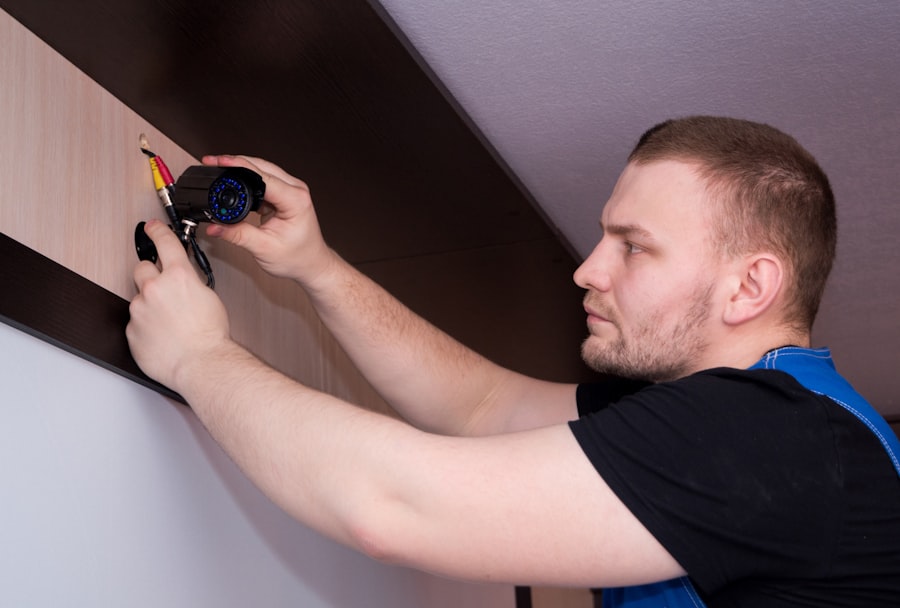
Ensuring adequate space and exercise for indoor quail is essential for promoting their physical health and mental well-being. As previously mentioned, providing at least 1 square foot of space per quail will allow them ample room to move around and exercise within their enclosure. Additionally, providing enrichment such as dust baths, perches, and hiding spots can encourage natural behaviors and physical activity.
Furthermore, allowing supervised free-range time outside of their enclosure can provide additional exercise opportunities for indoor quail. This can be achieved by setting up a secure outdoor area with access to fresh grass or dirt where they can scratch around and explore.
In addition to physical exercise, mental stimulation is also important for indoor quail. Providing toys or puzzles that encourage natural behaviors such as pecking or scratching can help keep them mentally engaged and prevent boredom.
Ensuring adequate space and exercise for indoor quail involves providing at least 1 square foot of space per bird within their enclosure, offering enrichment such as dust baths, perches, hiding spots, allowing supervised free-range time outside of their enclosure, and providing mental stimulation through toys or puzzles.
Ensuring adequate space and exercise for indoor quail involves providing at least 1 square foot of space per bird within their enclosure which allows them ample room to move around and exercise. Additionally, providing enrichment such as dust baths, perches, hiding spots can encourage natural behaviors and physical activity.
Furthermore, allowing supervised free-range time outside of their enclosure can provide additional exercise opportunities for indoor quail by setting up a secure outdoor area with access to fresh grass or dirt where they can scratch around and explore.
Monitoring the health and behavior of indoor quail
Monitoring the health and behavior of indoor quail involves being observant of any changes in their appearance or behavior that may indicate potential health issues or stress. It is important to regularly observe their eating habits, activity level, vocalizations, feather condition, droppings, and overall demeanor.
Additionally, it is important to handle them gently on a regular basis in order to check for any signs of injury or illness such as wounds or abnormal lumps. Providing proper veterinary care when needed will help ensure that any health issues are addressed promptly.
Furthermore, monitoring their behavior such as aggression or excessive pecking can indicate stress or overcrowding within their living environment. Making adjustments such as providing additional hiding spots or separating aggressive individuals may help alleviate these issues.
Monitoring the health and behavior of indoor quail involves being observant of any changes in their appearance or behavior that may indicate potential health issues or stress by regularly observing their eating habits, activity level vocalizations feather condition droppings overall demeanor handling them gently on a regular basis in order check for any signs of injury or illness such as wounds or abnormal lumps providing proper veterinary care when needed making adjustments such as providing additional hiding spots or separating aggressive individuals may help alleviate these issues.
Monitoring the health and behavior of indoor quail involves being observant of any changes in their appearance or behavior that may indicate potential health issues or stress by regularly observing their eating habits activity level vocalizations feather condition droppings overall demeanor handling them gently on a regular basis in order check for any signs of injury or illness such as wounds or abnormal lumps providing proper veterinary care when needed making adjustments such as providing additional hiding spots or separating aggressive individuals may help alleviate these issues.
Monitoring the health and behavior of indoor quail involves being observant of any changes in their appearance or behavior that may indicate potential health issues or stress. This can be done by regularly observing their eating habits, activity level, vocalizations, feather condition, and droppings. Additionally, paying attention to their overall demeanor and handling them gently on a regular basis in order to check for any signs of injury or illness, such as wounds or abnormal lumps, is important. Providing proper veterinary care when needed and making adjustments, such as providing additional hiding spots or separating aggressive individuals, may help alleviate these issues.
If you’re considering keeping quail indoors, you may also be interested in learning about the importance of providing proper heating for a chicken coop. Poultry Wizard offers a helpful article on choosing the right heater for a chicken coop, which can be crucial for maintaining a comfortable environment for your birds. Check out their guide here to ensure that your feathered friends stay warm and healthy during colder months.
FAQs
What are the benefits of keeping quail indoors?
Quail can be kept indoors for various reasons, including convenience, protection from predators, and the ability to closely monitor their environment and health.
What do quail need to thrive indoors?
Quail require a suitable living space with proper ventilation, access to natural light, a balanced diet, and regular cleaning and maintenance of their living area.
What type of housing is suitable for indoor quail?
Indoor quail housing should provide enough space for the birds to move around comfortably, as well as nesting areas, perches, and access to food and water. It should also be easy to clean and maintain.
What should be included in an indoor quail diet?
Quail require a balanced diet that includes a high-quality commercial feed, as well as access to fresh greens, insects, and grit for digestion. It’s important to provide a source of calcium, such as crushed oyster shells, for egg-laying hens.
How can I ensure the health and well-being of indoor quail?
Regular monitoring of the quail’s behavior, diet, and living conditions is essential for maintaining their health and well-being. It’s also important to provide regular veterinary care and to be aware of common health issues that may affect quail.
Are there any legal considerations for keeping quail indoors?
It’s important to check local regulations and zoning laws before keeping quail indoors, as some areas may have restrictions on keeping poultry or specific requirements for their housing and care.
Meet Walter, the feathered-friend fanatic of Florida! Nestled in the sunshine state, Walter struts through life with his feathered companions, clucking his way to happiness. With a coop that’s fancier than a five-star hotel, he’s the Don Juan of the chicken world. When he’s not teaching his hens to do the cha-cha, you’ll find him in a heated debate with his prized rooster, Sir Clucks-a-Lot. Walter’s poultry passion is no yolk; he’s the sunny-side-up guy you never knew you needed in your flock of friends!

